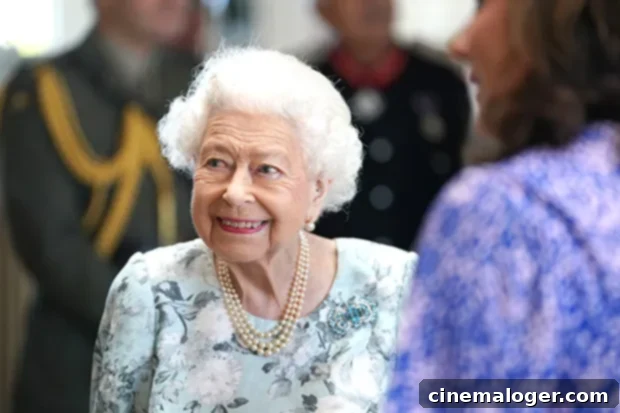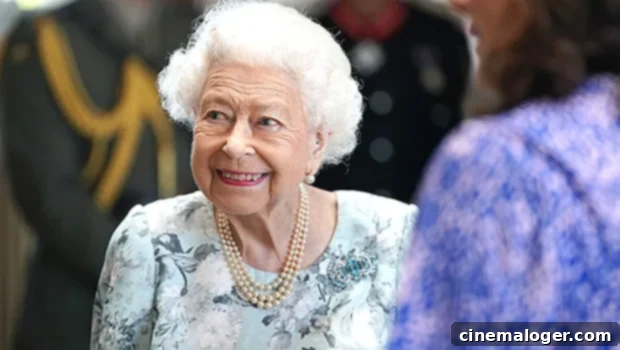Old Age Confirmed: Unpacking Queen Elizabeth II’s Final Days and Her Unforgettable Legacy
More than three weeks after the world bid a sorrowful farewell to Her Majesty Queen Elizabeth II, the official cause of her passing has been formally disclosed. On September 29, 2022, the National Records of Scotland released the monarch’s death certificate, confirming that the longest-reigning sovereign in British history died of “old age” at the venerable age of 96. This official revelation brought a definitive conclusion to speculation surrounding the beloved Queen’s final moments, while also underscoring the natural end to a life dedicated entirely to service.
The certificate, a document of historical significance, listed Princess Anne, the Queen’s only daughter, as the informant, having been present during her mother’s final hours. It also precisely recorded her official time of death as 3:10 p.m. on September 8, 2022. The confirmation of “old age” as the cause of death is a common and accepted medical term for individuals of advanced years whose bodily systems naturally decline. For a monarch who lived a life under intense scrutiny and demanding public duty, this simple cause offered a poignant, understated end to an extraordinary reign.
The Final Day: A Nation Holds Its Breath
The morning of September 8, 2022, was etched into the collective memory of Britain and the world as news emerged that Queen Elizabeth II was under “medical supervision” at her beloved Balmoral Castle in Scotland. This unprecedented announcement from Buckingham Palace signaled a grave concern for her health, prompting an immediate gathering of the Royal Family. Senior members, including her children Prince Charles (now King Charles III), Princess Anne, Prince Andrew, and Prince Edward, along with grandsons Prince William and Prince Harry, swiftly traveled to Balmoral to be at her bedside. The palpable anxiety among the public grew throughout the day as official updates remained scarce, yet the flurry of royal movements painted a somber picture.
The Queen had spent much of the summer at Balmoral, her private Scottish estate, a place she cherished for its tranquility and connection to nature. The fact that her final moments occurred there, surrounded by family, offered a degree of comfort amidst the profound sadness. Three hours after her official time of death at 3:10 p.m., the Palace released a short, poignant statement to the world: “The Queen died peacefully at Balmoral this afternoon. The King and The Queen Consort will remain at Balmoral this evening and will return to London tomorrow.” This understated announcement confirmed the irreversible loss that had quietly taken place, ushering in an immediate and profound period of national mourning. The statement, simple yet deeply impactful, formally announced the end of an era and the dawn of a new one under King Charles III.

King Charles III: An Immediate Ascension and Poignant Address
With Queen Elizabeth II’s passing, the crown immediately and seamlessly transferred to her eldest son, Charles, who became King Charles III. His first official act as monarch was to issue a deeply personal and moving statement in response to his mother’s death. Posted on the Royal Family’s social media accounts, the message resonated deeply with a grieving nation and a sympathetic world. “The death of my beloved Mother, Her Majesty The Queen, is a moment of the greatest sadness for me and all members of my family,” he began, articulating the profound personal loss intertwined with his new public duty.
King Charles III’s statement continued to acknowledge the immense impact of his mother’s seven-decade reign. “We mourn profoundly the passing of a cherished Sovereign and a much-loved Mother. I know her loss will be deeply felt throughout the country, the Realms, and the Commonwealth, and by countless people around the world. During this period of mourning and change, my family and I will be comforted and sustained by our knowledge of the respect and deep affection in which The Queen was so widely held.” These words not only conveyed his personal sorrow but also highlighted his immediate understanding of the global significance of her reign and the affection she commanded. It was a powerful first address from a new King stepping into the immense shoes of his legendary predecessor, promising continuity while honoring the Queen’s extraordinary legacy.
A Reign of Unprecedented Longevity and Devotion to Duty
Queen Elizabeth II’s passing marked the end of the second Elizabethan Age, a period defined by her unwavering commitment to duty and service. Her reign of 70 years was a monumental achievement, making her the longest-serving monarch in British history, surpassing even Queen Victoria. Her time on the throne spanned an era of immense societal, technological, and political transformation, from the post-war recovery to the digital age, and she remained a constant, reassuring presence amidst it all.
Just months before her death, in late June 2022, the nation celebrated her Platinum Jubilee, an unprecedented set of festivities across England and the Commonwealth. Millions participated in street parties, concerts, and pageants, demonstrating the profound affection and respect held for her. However, even then, her growing health concerns prevented her from attending all the events, a poignant foreshadowing of her eventual decline. Despite her physical frailty, her spirit remained strong, and her appearance on the Buckingham Palace balcony for the Jubilee celebrations was met with thunderous applause, a final, cherished public moment of widespread adoration.
From Unexpected Heir to Steadfast Sovereign
Born on April 21, 1926, Princess Elizabeth Alexandra Mary was never initially expected to ascend to the throne. She was the eldest daughter of The Duke and Duchess of York (later King George VI and Queen Elizabeth). Her life irrevocably changed in 1936 with the dramatic abdication of her uncle, King Edward VIII, who chose to marry American divorcee and socialite Wallis Simpson against constitutional advice. This seismic event propelled her father onto the throne as King George VI, instantly making young Princess Elizabeth the heir presumptive.
The weight of this unexpected destiny settled upon her at a tender age, shaping her future and preparing her for a life of unparalleled public service. Following the sad and premature death of her father in 1952, Princess Elizabeth became Queen Elizabeth II at just 25 years old. She embraced her role with remarkable grace and determination, dedicating her entire life to the service of her people and the Commonwealth. A birthday post from the Royal Family on April 21, 2022, celebrating her 96th year, fondly recalled this journey: “Today as The Queen turns 96, we’re sharing this photograph taken when she was 2-years-old. Then Princess Elizabeth, she was the eldest daughter of The Duke and Duchess of York and was never expected to become Queen. Her life changed in 1936 when her uncle, King Edward VIII abdicated, her father became King George VI and the young Princess became the heir presumptive. Following the sad death of her father in 1952, Princess Elizabeth became Queen Elizabeth II aged just 25, and this year is celebrating 70 years on the throne – a first in British history.” This retrospective highlights the sheer improbability of her long and storied reign.
A Life Partner and Enduring Strength
For much of her historic reign, Queen Elizabeth II was supported by her beloved husband, Prince Philip, Duke of Edinburgh. His passing on April 9, 2021, at the age of 99, marked a significant personal loss for the Queen and a moment of national mourning. Their marriage of over 73 years was a cornerstone of stability for the monarchy, with Prince Philip famously describing his role as the Queen’s “strength and stay.” His absence was deeply felt, and many observers noted the increasing frailty of the Queen in the months following his death. The iconic image of her sitting alone at his funeral due to COVID-19 restrictions became a powerful symbol of her personal resilience and the challenges of the modern era.
An Enduring Legacy
Queen Elizabeth II’s reign was a testament to consistency, duty, and quiet strength. She navigated the monarchy through turbulent times, maintaining its relevance and respect in a rapidly changing world. Her ability to remain apolitical, yet deeply connected to the pulse of her nation and the Commonwealth, earned her admiration across the globe. Her death, confirmed by the simple cause of “old age,” was a natural conclusion to a life lived fully and purposefully, a life that touched millions. Her legacy is one of unwavering service, a beacon of stability, and an embodiment of dedication that will continue to inspire for generations to come. The end of her reign marked not just the passing of a monarch, but the close of a remarkable chapter in global history.
